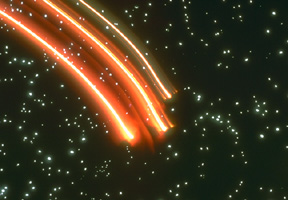An artist's depiction of a shooting star. Look out for meteors of all sizes during the shower this month!
Click on image for full size
Courtesy of Corel Photography
Make a wish on a shooting star! It's time for the Perseid meteor shower!
News story originally written on August 8, 2002
If you are in the Northern Hemisphere, you may be able to see hundreds of meteors an hour during the nights of August 12th and 13th, 2002, when the Perseid meteor shower is at its peak.
Look for meteors in cloudless skies after two a.m. and before the sun begins to rise. They will be shooting through the northeast part of the sky. The meteors will be most noticeable to people in Europe on August 13. North Americans can see the most meteors on either August 12th or 13th.
Earlier in the evening, at 9 or 10 pm, you might be able to see Earthgrazers, meteors that streak slowly and colorfully through the atmosphere near the horizon.
Perseid meteoroids are little pieces of the comet Swift-Tuttle. This comet has a lot of dusty debris that travels along with it. The dust forms a cloud that the Earth speeds through every year at about this time. They may be tiny, but these dust particles can make some very bright streaks of colorful light through the night sky!
Last modified August 8, 2002 by Lisa Gardiner.
You might also be interested in:

It was another exciting and frustrating year for the space science program. It seemed that every step forward led to one backwards. Either way, NASA led the way to a great century of discovery. Unfortunately,
...more
The Space Shuttle Discovery lifted off from Kennedy Space Center on October 29th at 2:19 p.m. EST. The weather was great as Discovery took 8 1/2 minutes to reach orbit. This was the United States' 123rd
...more
A moon was discovered orbiting the asteroid, Eugenia. This is only the second time in history that a satellite has been seen circling an asteroid. A special mirror allowed scientists to find the moon
...more
Will Russia ever put the service module for the International Space Station in space? NASA officials want an answer from the Russian government. The necessary service module is currently waiting to be
...more
A coronal mass ejection (CME) happened on the Sun early last month. The material that was thrown out from this explosion passed the ACE spacecraft. The SWICS instrument on ACE has produced a new and very
...more
J.S. Maini of the Canadian Forest Service called forests the "heart and lungs of the world." This is because forests filter air and water pollution, absorb carbon dioxide, release oxygen, and maintain
...more
In late April through mid-May 2002, all five naked-eye planets are visible at the same time in the night sky! This is includes Mercury which is generally very hard to see. You won't want to miss this!
...more















